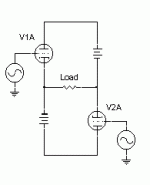*So it is stucked here, I would like to see some schematics and *I'm still querious what it is electrokompaniet does.
*How do they calculate the amount of capacity?
*Or is it just a sale frase?
*/Magnus
Please see my post #25. EC FFT is explained there.
Noize.
*How do they calculate the amount of capacity?
*Or is it just a sale frase?
*/Magnus
Please see my post #25. EC FFT is explained there.
Noize.
I do not know about how Electrocompagniet does it, however I think that there is a lot to win with such a circuit😉Or is it just a sale frase?
I got the name of the norweigen guy I couldn't remenber earlier. It's Leif Ernstsen and his products are called "Dynamic Precision".
Here is the link:
http://www.dynamicprecision.no
Happy reading🙂
Dynamic Precision, I know about them.
Maybee I know someone that could get me some more information. I have an old friend to my brother that used to sell them, maybee still, who knows. Will have my brother ask him!
/Magnus
Maybee I know someone that could get me some more information. I have an old friend to my brother that used to sell them, maybee still, who knows. Will have my brother ask him!
/Magnus
Dear Jan and Magnus,
You are discussing the amplifier with small switching distortion, when a low-power class A amplifier is connected in series with a high power class B amplifier. The technique is at least 25 years old:
N.Sano, T.Hayashi, H.Ogawa,"A high-efficiency class-A audio amplifier", AES preprint 1382, 1978
Why do you name it FFT (floating transformer technology)? Can you read Noize post?
You are discussing the amplifier with small switching distortion, when a low-power class A amplifier is connected in series with a high power class B amplifier. The technique is at least 25 years old:
N.Sano, T.Hayashi, H.Ogawa,"A high-efficiency class-A audio amplifier", AES preprint 1382, 1978
Why do you name it FFT (floating transformer technology)? Can you read Noize post?
Dimitri,
You are absolutely right. This is not FFT. The circlotron, discussed in tons of posts on this forum, is. So is the tube version called PPP (parallel push-pull). In each case you have like two SE amps, each with a load which is in the cathode (or emitter or source) lead, the amp element (tube or ss) and a supply in a loop as always. Each set is driven in opposite phase. The trick is that the load is connected between the two cathodes (emitters, sources...). So, each side of the load also moves the suplly up and down with the outout signal, hence the name. Try to draw it, real easy.
There's one caveat: the circuit needs a ground reference for the driver stage, so mostly you see the midpoint of the load grounded, either by two resistors across the load with their midpoint grounded, or a choke with a midpoint tap grounded across the load. Probably many other solutions I'm not (yet) aware off.
Jan Didden
You are absolutely right. This is not FFT. The circlotron, discussed in tons of posts on this forum, is. So is the tube version called PPP (parallel push-pull). In each case you have like two SE amps, each with a load which is in the cathode (or emitter or source) lead, the amp element (tube or ss) and a supply in a loop as always. Each set is driven in opposite phase. The trick is that the load is connected between the two cathodes (emitters, sources...). So, each side of the load also moves the suplly up and down with the outout signal, hence the name. Try to draw it, real easy.
There's one caveat: the circuit needs a ground reference for the driver stage, so mostly you see the midpoint of the load grounded, either by two resistors across the load with their midpoint grounded, or a choke with a midpoint tap grounded across the load. Probably many other solutions I'm not (yet) aware off.
Jan Didden
Right Frank! It's easy to see that the supply (and thus it's xformers) float with the music so to say. But there must be a ground reference somewhere on the output stage, yes? Like middle of the load?
Jan Didden
Jan Didden
Hi Jan et all,
Exactly.
And that's also what I don't like about them; in the case of an 8 Ohm speaker virtual ground would be the midpoint namely 4 ohm either side.
With an OPT this isn't a big deal though...
Cheers,😉
But there must be a ground reference somewhere on the output stage, yes? Like middle of the load?
Exactly.
And that's also what I don't like about them; in the case of an 8 Ohm speaker virtual ground would be the midpoint namely 4 ohm either side.
With an OPT this isn't a big deal though...
Cheers,😉
Thanks,
Yes I read "noize" post and realize that it isn't FTT and I have read alot of the circlotron posts the last two days with much interest.
Now I'm more curious of, how electrokompaniet calculate their caps, they say that less is better, but I don't think nothing is the best.
/Magnus
Yes I read "noize" post and realize that it isn't FTT and I have read alot of the circlotron posts the last two days with much interest.
Now I'm more curious of, how electrokompaniet calculate their caps, they say that less is better, but I don't think nothing is the best.
/Magnus
I would think the size of the caps (capacity) should not change from a " normal" circuit or a circlotron. You look at the supply voltage, the load current and that determines as ususal the capacitance.
Frank: In the (very) old days I built these amps with 800 Ohms speakers, the Philips 9710 series. It was easy to get a small choke with midtap (or two chokes in series), and put that across the load. With an 8 Ohms load, I think 2 x 100 Ohms or so should do the trick. It's basically a DC reference you need.
Jan Didden
Frank: In the (very) old days I built these amps with 800 Ohms speakers, the Philips 9710 series. It was easy to get a small choke with midtap (or two chokes in series), and put that across the load. With an 8 Ohms load, I think 2 x 100 Ohms or so should do the trick. It's basically a DC reference you need.
Jan Didden
Hi,
Fred,
That's because you earthed the midpoint...
Jan,
He,he...my cousin had the Philips 800 ohm (AD something) , I had made the amps.
Every school holiday outside the big two month "grote vakantie" the amps and Frank travelled to Amsterdam.
You're correct about the resistors, for some odd reason they never appeared on the original Wiggins. Probably because they used high Ohmic speakers as well? I dunno.
Cheers,😉
Fred,
All the transformers I have used were heavy enough to sink like a rock.........
That's because you earthed the midpoint...
Jan,
Frank: In the (very) old days I built these amps with 800 Ohms speakers, the Philips 9710 series. It was easy to get a small choke with midtap (or two chokes in series), and put that across the load. With an 8 Ohms load, I think 2 x 100 Ohms or so should do the trick. It's basically a DC reference you need.
He,he...my cousin had the Philips 800 ohm (AD something) , I had made the amps.
Every school holiday outside the big two month "grote vakantie" the amps and Frank travelled to Amsterdam.
You're correct about the resistors, for some odd reason they never appeared on the original Wiggins. Probably because they used high Ohmic speakers as well? I dunno.
Cheers,😉
Re: Floating?
Ah! But that's where those xformers with wood cores come in. Also have much lower eddy current and iron losses.
Jan Didden
Fred Dieckmann said:All the transformers I have used were heavy enough to sink like a rock.........
Ah! But that's where those xformers with wood cores come in. Also have much lower eddy current and iron losses.
Jan Didden
Hi,
They're very poplar in Holland, often made out of old "klompen".
When highly oversized you can even cross the Amstel with them.
Cheers,😉
Wil Blauw winding poplar cored trannies:
Ah! But that's where those xformers with wood cores come in. Also have much lower eddy current and iron losses.
They're very poplar in Holland, often made out of old "klompen".
When highly oversized you can even cross the Amstel with them.
Cheers,😉
Wil Blauw winding poplar cored trannies:
Attachments
- Status
- Not open for further replies.
- Home
- Amplifiers
- Solid State
- Floating Transformer Technology


